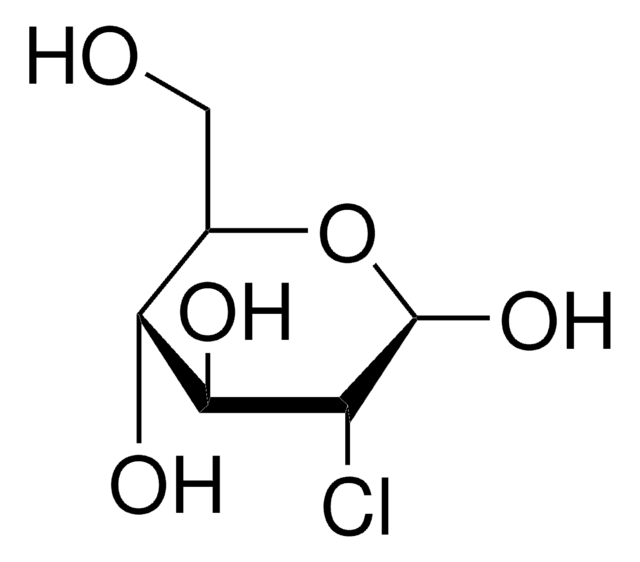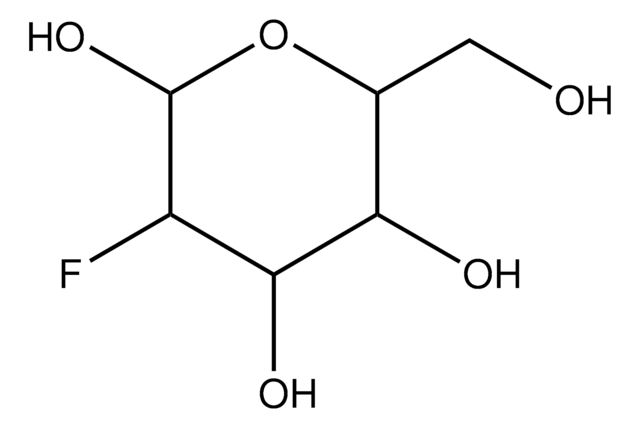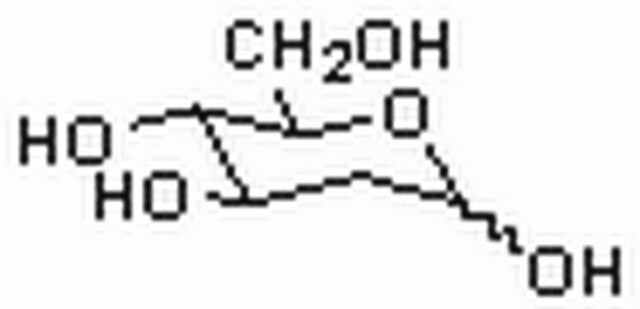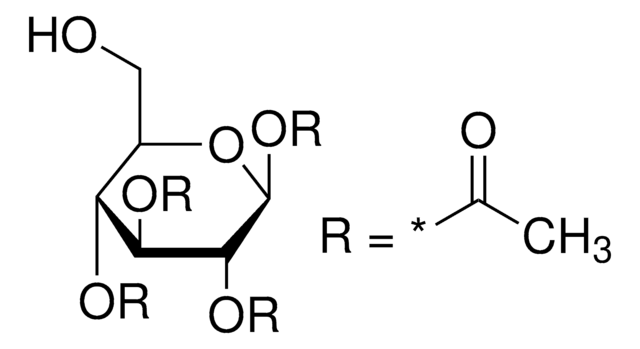F5006
2-Fluoro-2-deoxy-D-glucose
glycosylation inhibitor, glucose analog
Synonym(s):
2-Deoxy-2-fluoro-D-glucose, FDG, 2-Deoxy-2-fluoro-D-glucose
Sign Into View Organizational & Contract Pricing
All Photos(2)
About This Item
Empirical Formula (Hill Notation):
C6H11FO5
CAS Number:
Molecular Weight:
182.15
MDL number:
UNSPSC Code:
41116107
PubChem Substance ID:
NACRES:
NA.32
Recommended Products
Quality Level
storage temp.
2-8°C
SMILES string
OCC1OC(O)C(F)C(O)C1O
InChI
1S/C6H11FO5/c7-3-5(10)4(9)2(1-8)12-6(3)11/h2-6,8-11H,1H2
InChI key
ZCXUVYAZINUVJD-UHFFFAOYSA-N
Looking for similar products? Visit Product Comparison Guide
General description
2-Fluoro-2-deoxy-D-glucose is non-toxic and a structural analog of glucose, significantly inhibiting glycosylation. As a glucose analog, uptake of 2-Fluoro-2-deoxy-D-glucose is rapid in brain and heart cells.
2-Fluoro-2-deoxy-D-glucose can be taken up by cells but does not undergo metabolic glycolysis.
2-Fluoro-2-deoxy-D-glucose can be taken up by cells but does not undergo metabolic glycolysis.
Application
2-Fluoro-2-deoxy-D-glucose is used as a tracer for rapid tumor detection. It is used as a glucose analog to study glucose uptake in mice with radiation and burn injuries. Oncology therapy studies use FDG in combination with PET (Positron Emission Topography)
Biochem/physiol Actions
Glucose analog that inhibits cellular glycosylation.
Signal Word
Warning
Hazard Statements
Precautionary Statements
Hazard Classifications
Eye Irrit. 2 - Skin Irrit. 2 - STOT SE 3
Target Organs
Respiratory system
Storage Class Code
11 - Combustible Solids
WGK
WGK 3
Flash Point(F)
Not applicable
Flash Point(C)
Not applicable
Personal Protective Equipment
dust mask type N95 (US), Eyeshields, Gloves
Choose from one of the most recent versions:
Already Own This Product?
Find documentation for the products that you have recently purchased in the Document Library.
Customers Also Viewed
Johan Stender et al.
Lancet (London, England), 384(9942), 514-522 (2014-04-22)
Bedside clinical examinations can have high rates of misdiagnosis of unresponsive wakefulness syndrome (vegetative state) or minimally conscious state. The diagnostic and prognostic usefulness of neuroimaging-based approaches has not been established in a clinical setting. We did a validation study
Imke Schatka et al.
Journal of nuclear medicine : official publication, Society of Nuclear Medicine, 55(1), 99-106 (2013-11-16)
Sarcoidosis is a systemic granulomatous disease of unknown etiology. Cardiac involvement may occur, leading to an adverse outcome. Although early treatment to improve morbidity and mortality is desirable, sensitive and accurate detection of cardiac sarcoidosis remains a challenge. Accordingly, interest
Sandy R Shultz et al.
Epilepsia, 54(7), 1240-1250 (2013-05-31)
Posttraumatic epilepsy (PTE) occurs in a proportion of traumatic brain injury (TBI) cases, significantly compounding the disability, and risk of injury and death for sufferers. To date, predictive biomarkers for PTE have not been identified. This study used the lateral
Dennis Vriens et al.
Cancer, 117(20), 4582-4594 (2011-03-25)
Indeterminate results at fine-needle aspiration biopsy (FNAB) of thyroid nodules pose a clinical dilemma, because only 20% to 30% of patients suffer from malignancy. Previous studies suggested that the false-negative ratio of [(18)F]-2-fluoro-2-deoxy-D-glucose-positron emission tomography (FDG-PET) is very low; therefore
Maarten J Vosselman et al.
The American journal of clinical nutrition, 98(1), 57-64 (2013-05-31)
Studies in rodents have shown that brown adipose tissue (BAT) is activated on food intake, thereby reducing metabolic efficiency. The current study investigated whether a single high-calorie, carbohydrate-rich meal activates BAT in lean human adults. BAT activity was studied in
Our team of scientists has experience in all areas of research including Life Science, Material Science, Chemical Synthesis, Chromatography, Analytical and many others.
Contact Technical Service





